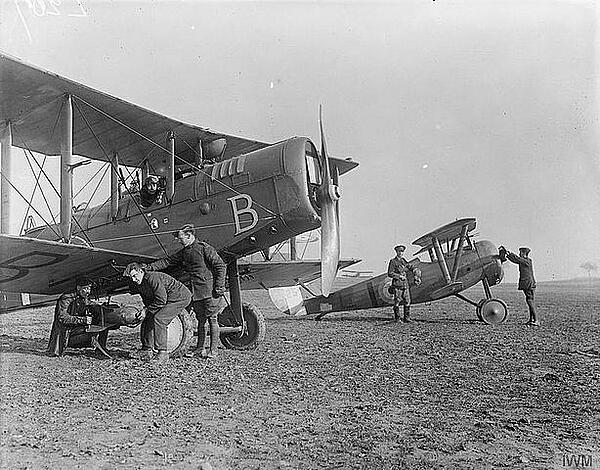Aircraft and World War One
At the beginning of World War One, aircraft were very basic and crude in design. However, by the end of the war, aircraft featured some incredibly sophisticated technology. They had even split into different types, including fighters, bombers and long-range bombers.
All this development was a result of the increasing demands and pressure of the war, as well as changes to the tactics that dictated aircraft needed to be used in different ways. While at the start of the war, British pilots weer part of the British Army and had army ranks, the pilots at the end of the war had gone through from Royal Flying Corps to the newly created Royal Air Force, which was an independent division with its own command structure.

At the start of the war, just 11 years after the Wright brothers had flown their aircraft, aeroplanes were so crude that new pilots in the Royal Flying Corps had a greater chance of being killed during training than they did in combat. Navigation was even based on maps, with pilots looking for specific landmarks from the air.
This reflected the views of the British Army, who felt aircraft was “useless in war” and could only be used for reconnaissance or intelligence - such as recording German movements, taking photographs and establishing information ahead of artillery strikes. Should German and Allied pilots see each other in the air, the combat was very basic but very deadly. This was mostly due to the cramped cockpit, which barely had room for even a parachute. However, this was almost irrelevant as senior commanders forbade the use of parachutes, stating that they dampened the fighting spirit of the pilots. Mick Mannock, flying ace, famously carried a pistol in his cockpit so he could use it on himself if his plane caught on fire to avoid a painful and prolonged death.
Despite the initial reluctance of the military to access aeroplanes as valuable weapons, as the war progress their value did seem to increase in the estimation of many senior commanders. Two different types of aircraft - the fighter and the bomber - started to be developed, representing a whole new era for aircraft.
The first aircraft used in the war in 1914 was the Avro 504, and this was also the first aircraft shot down by the enemy. This plane became more and more efficient as it was developed, but it never achieved the same reputation as the Sopwith Camel, which was known to be a reliable fighter aircraft. However, the Fokker Dr. Triplane eclipsed all others in terms of its reputation, particularly as it was associated with German flying ace Manfred von Richthoften.
Bombers also developed swiftly. At the start of the war, the planes would simply drop a small bomb over the side of the aircraft. If this bomb made it to the target it was usually due to good luck rather than anything else. However, by the end of the war, long-range bombers had been developed that were able to carry many more bombs with a degree of accuracy. For the Germans, this was the Gotha bomber, while the British had the Handley Page bomber. These aircraft made an aerial attack possible, allowing the military from both sides to bomb civilians as well as crucial industry buildings such as factories.
MLA Citation/Reference
"Aircraft and World War One". HistoryLearning.com. 2024. Web.
